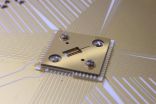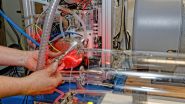The study, entitled "Self-motion perception in autism is compromised by visual noise but integrated optimally across multiple senses," was published online in the Proceedings of the National Academy of Sciences on May 4th, 2015. The authors of the study are Adam Zaidel, of Israel's Bar-Ilan University, and Robin P. Goin-Kochel and Dora E. Angelaki, of Baylor College of Medicine in the United States.
Perceptual Impairment in Autism - a "Noisy" Controversy
One of the hallmarks of Autism Spectrum Disorder (ASD) is superior low-level task performance alongside reduced performance in tasks that involve the processing of complex sensory data. This has led to the assumption that autism is characterized by a difficulty integrating individual units of perceptual data into global concepts. In line with this first assumption, it has further been proposed that individuals with autism have difficulty integrating multi-sensory input.
With its unique experimental set-up, the new study has successfully challenged this conventional wisdom. Moreover, it has identified a neurological phenomenon associated with autism pathology: a heightened sensitivity to "noisy" sensory signals.
"Theories of global and multisensory integration deficits in ASD are deeply rooted in the scientific conversation about autism," says Dr. Adam Zaidel, a member of Bar-Ilan University's Gonda (Goldschmied) Multidisciplinary Brain Research Center, who is the publication's lead author. "Recently, this notion has come under scrutiny, as more and more investigators have observed discrepancies with experimental results."
"In this study we show that heightened sensitivity to sensory noise - the random signals inserted into the visual tasks traditionally used by scientists to test sensory integration levels in autism - may provide an alternative explanation for impaired performance. When this noise is removed from the equation, the integration of visual motion stimuli in ASD is equal to, or maybe even superior to that of the control group. Moreover, our study demonstrates that the multi-sensory integration seen in autistic participants was comparable to that of the non-autistic control group."
A Problematic "Twist" in Traditional Testing: Noise
Zaidel explains that visual motion processing in ASD has generally been examined through the use of a computer-based tool in which study participants are asked to designate the overall direction of motion of a field of dots, while a certain number of dots - the "noise" in an otherwise coherent picture - are randomly displaced. In these experiments, the level of noise at which participants can no longer determine overall direction is seen as a measure of the participant's innate ability to integrate isolated visual stimuli into a global picture.
Zaidel's new approach proves that such traditional methods - which depend on noise as a modulator of task difficulty - have led to widespread misinterpretation of how individuals with ASD integrate visual stimuli.
"Our study is carried out in a 3D environment in which a field of moving dots generates the feeling of traveling through space, with different trials 'steering' to the right or left of straight ahead," Zaidel says. "By asking participants to indicate their perceived direction of movement, we test their ability to create a global picture out of individual details. Significantly - and this is where our method differs from previous tests - we can achieve measureable results both when randomized dots are included in the overall picture, and in a completely coherent, noise-free environment."
Zaidel says that when there were no randomly-moving dots, autistic participants performed well, successfully determining the direction of movement at a level similar to that achieved by the non-ASD control group. When the noisy signals were introduced, however, the ASD group was significantly more affected than controls. This indicates that it is the presence of noise - rather than any innate integration deficit - that makes the task more difficult for people with autism.
No Deficit: Re-Thinking Multi-Sensory Integration in ASD
The unique experimental platform also allowed Zaidel to challenge another theory that has emerged more recently: that people with ASD are neurologically pre-disposed toward deficient integration of multi-sensory stimuli.
The simulator used in the study was equipped with an ability to introduce movement into the chair in which the study participant was sitting - requiring the participant to respond to and interpret visual and vestibular stimuli at the same time.
"By adding movement to the experiment, we created a situation in which participants didn't just see the direction of the movement, but felt it as well," he says. "In this scenario, people with autism displayed intact multi-sensory integration, completing tasks in a normative manner, both in a coherent, noiseless environment, and even when noise was present. These findings raise questions about prevalent theories related to multi-sensory integration deficits in ASD."
Autism Thinks: Processing Sensory Stimuli vs. Accessing Prior Knowlege
According to Zaidel, the new study provides support for the idea that people with autism are highly sensitive to incoming sensory information. Moreover, he suggests, they are predisposed toward relying more highly on external stimulation - with less use of prior knowledge - when interpreting the world around them.
"Our results suggest that people with autism may experience a deficiency in what are known in the scientific literature as Bayesian priors - the ability to draw on existing knowledge to understand what we see and to predict what we will see in the near future," Zaidel says. "If you're more heavily weighted toward perceiving the world bottom up - from stimulus to perception - and relying less on rules of thumb from prior knowledge, perception will be both more taxing, and more sensitive to sensory noise."
In the future, Zaidel says, it may someday be possible to study this phenomenon directly in the brain, or to create treatments that might help autistic individuals become more adept at re-connecting to and using prior knowledge. However, he adds, future advances will depend on getting a clearer picture how the autistic brain processes sensory information and priors.
"In recent years, predominant theories about the nature of autism have become the subject of debate in the scientific community," he says. "At the same time, the incidence of ASD diagnosis is on the rise. It is vitally important to understand autism's underlying neuropathology, so that scientists can create the studies that have the best chance of helping us face this challenge."
INFORMATION:
This research was performed during Dr. Zaidel's post-doctoral fellowship at the Baylor College of Medicine, under the supervision of Prof. Dora Angelaki. The research was supported by a SFARI autism research initiative grant awarded to Prof. Angelaki's lab by the Simons Foundation.


